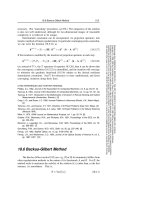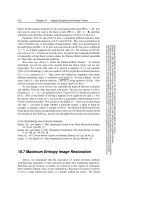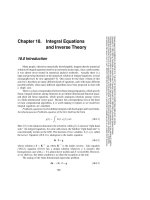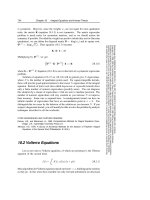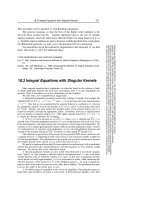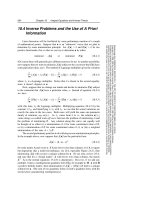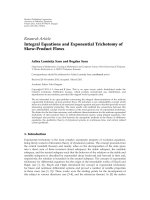Integral Equations and Inverse Theory part 8
Bạn đang xem bản rút gọn của tài liệu. Xem và tải ngay bản đầy đủ của tài liệu tại đây (122.9 KB, 9 trang )
818
Chapter 18. Integral Equations and Inverse Theory
Sample page from NUMERICAL RECIPES IN C: THE ART OF SCIENTIFIC COMPUTING (ISBN 0-521-43108-5)
Copyright (C) 1988-1992 by Cambridge University Press.Programs Copyright (C) 1988-1992 by Numerical Recipes Software.
Permission is granted for internet users to make one paper copy for their own personal use. Further reproduction, or any copying of machine-
readable files (including this one) to any servercomputer, is strictly prohibited. To order Numerical Recipes books,diskettes, or CDROMs
visit website or call 1-800-872-7423 (North America only),or send email to (outside North America).
(Don’t let this notation mislead you into inverting the full matrix W(x)+λS.You
only need to solve for some y the linear system (W(x)+λS)·y =R,andthen
substitute y into both the numerators and denominators of 18.6.12 or 18.6.13.)
Equations (18.6.12) and (18.6.13) have a completely different character from
thelinearly regularized solutionsto(18.5.7) and (18.5.8). The vectors andmatrices in
(18.6.12) all have size N, the number of measurements. There is no discretization of
the underlyingvariable x,soMdoes not come into play at all. One solves a different
N × N set of linear equations for each desired value of x. By contrast, in (18.5.8),
one solves an M × M linear set, but onlyonce. In general, the computational burden
of repeatedly solving linear systems makes the Backus-Gilbert method unsuitable
for other than one-dimensional problems.
How does one choose λ within the Backus-Gilbert scheme? As already
mentioned, you can (in some cases should) make the choice before you see any
actual data. For a given trial value of λ, and for a sequence of x’s, use equation
(18.6.12) to calculate q(x); then use equation (18.6.6) toplot the resolutionfunctions
δ(x, x
) as a function of x
. These plots will exhibit the amplitude with which
different underlying values x
contribute to the pointu(x) of your estimate. For the
same value of λ, also plot the function
Var [u(x )] using equation (18.6.8). (You
need an estimate of your measurement covariance matrix for this.)
As you change λ you will see very explicitly the trade-off between resolution
and stability. Pick the value that meets your needs. You can even choose λ to be a
function of x, λ = λ(x), in equations (18.6.12) and (18.6.13), should you desire to
do so. (This is one benefit of solving a separate set of equations for each x.) For
the chosen value or values of λ, you now have a quantitative understanding of your
inverse solution procedure. This can prove invaluable if — once you are processing
real data — you need to judge whether a particular feature, a spike or jump for
example, is genuine, and/or is actually resolved. The Backus-Gilbert method has
found particular success among geophysicists,who use it to obtaininformation about
the structure of the Earth (e.g., density run with depth) from seismic travel time data.
CITED REFERENCES AND FURTHER READING:
Backus, G.E., and Gilbert, F. 1968,
Geophysical Journal of the Royal Astronomical Society
,
vol. 16, pp. 169–205. [1]
Backus, G.E., and Gilbert, F. 1970,
Philosophical Transactions of the Royal Society of London
A
, vol. 266, pp. 123–192. [2]
Parker, R.L. 1977,
Annual Review of Earth and Planetary Science
, vol. 5, pp. 35–64. [3]
Loredo, T.J., and Epstein, R.I. 1989,
Astrophysical Journal
, vol. 336, pp. 896–919. [4]
18.7 Maximum Entropy Image Restoration
Above, we commented that the association of certain inversion methods
with Bayesian arguments is more historical accident than intellectual imperative.
Maximum entropy methods, so-called, are notorious in this regard; to summarize
these methods without some, at least introductory, Bayesian invocations would be
to serve a steak without the sizzle, or a sundae without the cherry. We should
18.7 Maximum Entropy Image Restoration
819
Sample page from NUMERICAL RECIPES IN C: THE ART OF SCIENTIFIC COMPUTING (ISBN 0-521-43108-5)
Copyright (C) 1988-1992 by Cambridge University Press.Programs Copyright (C) 1988-1992 by Numerical Recipes Software.
Permission is granted for internet users to make one paper copy for their own personal use. Further reproduction, or any copying of machine-
readable files (including this one) to any servercomputer, is strictly prohibited. To order Numerical Recipes books,diskettes, or CDROMs
visit website or call 1-800-872-7423 (North America only),or send email to (outside North America).
also comment in passing that the connection between maximum entropy inversion
methods, considered here, and maximum entropy spectral estimation, discussed in
§13.7, is rather abstract. For practical purposes the two techniques, though both
named maximum entropy method or MEM, are unrelated.
Bayes’ Theorem, which followsfrom the standard axioms of probability,relates
the conditional probabilities of two events, say A and B:
Prob(A|B)=Prob(A)
Prob(B|A)
Prob(B)
(18.7.1)
Here Prob(A|B) is the probability of A given that B has occurred, and similarly for
Prob(B|A), while Prob(A) and Prob(B) are unconditional probabilities.
“Bayesians” (so-called) adopt a broader interpretation of probabilities than do
so-called “frequentists.” To a Bayesian, P (A|B) is a measure of the degree of
plausibilityof A (given B) on a scale ranging from zero to one. In this broader view,
A and B need not be repeatable events; they can be propositions or hypotheses.
The equations of probability theory then become a set of consistent rules for
conducting inference
[1,2]
. Since plausibility is itself always conditioned on some,
perhaps unarticulated, set of assumptions, all Bayesian probabilities are viewed as
conditional on some collective background information I.
Suppose H is some hypothesis. Even before there exist any explicit data,
a Bayesian can assign to H some degree of plausibility Prob(H|I), called the
“Bayesian prior.” Now, when some data D
1
comes along, Bayes theorem tells how
to reassess the plausibility of H,
Prob(H|D
1
I)=Prob(H|I)
Prob(D
1
|HI)
Prob(D
1
|I)
(18.7.2)
The factor in the numerator on the right of equation (18.7.2) is calculable as the
probability of a data set given the hypothesis (compare with “likelihood” in §15.1).
The denominator, called the “prior predictive probability” of the data, is in this case
merely a normalization constant which can be calculated by the requirement that
the probability of all hypotheses should sum to unity. (In other Bayesian contexts,
the prior predictive probabilities of two qualitatively different models can be used
to assess their relative plausibility.)
If some additional data D
2
comes along tomorrow, we can further refine our
estimate of H’s probability, as
Prob(H|D
2
D
1
I)=Prob(H|D
1
I)
Prob(D
2
|HD
1
I)
Prob(D
1
|D
1
I)
(18.7.3)
Using the product rule for probabilities, Prob(AB|C)=Prob(A|C)Prob(B|AC),
we find that equations (18.7.2) and (18.7.3) imply
Prob(H|D
2
D
1
I)=Prob(H|I)
Prob(D
2
D
1
|HI)
Prob(D
2
D
1
|I)
(18.7.4)
which shows that we would have gotten the same answer if all the data D
1
D
2
had been taken together.
820
Chapter 18. Integral Equations and Inverse Theory
Sample page from NUMERICAL RECIPES IN C: THE ART OF SCIENTIFIC COMPUTING (ISBN 0-521-43108-5)
Copyright (C) 1988-1992 by Cambridge University Press.Programs Copyright (C) 1988-1992 by Numerical Recipes Software.
Permission is granted for internet users to make one paper copy for their own personal use. Further reproduction, or any copying of machine-
readable files (including this one) to any servercomputer, is strictly prohibited. To order Numerical Recipes books,diskettes, or CDROMs
visit website or call 1-800-872-7423 (North America only),or send email to (outside North America).
From a Bayesian perspective, inverse problems are inference problems
[3,4]
.
Theunderlyingparameter set u is a hypothesiswhoseprobability,given the measured
data values c, and the Bayesian prior Prob(u|I) can be calculated. We might want
to report a single “best” inverse u, the one that maximizes
Prob(u|cI)=Prob(c|uI)
Prob(u|I)
Prob(c|I)
(18.7.5)
over all possible choices of u. Bayesian analysis also admits the possibility of
reporting additional information that characterizes the region of possible u’s with
high relative probability, the so-called “posterior bubble” in u.
The calculation of the probabilityof the data c, given the hypothesis u proceeds
exactly as in the maximumlikelihoodmethod. ForGaussian errors, e.g., it is givenby
Prob(c|uI)=exp(−
1
2
χ
2
)∆u
1
∆u
2
···∆u
M
(18.7.6)
where χ
2
is calculated from u and c using equation (18.4.9), and the ∆u
µ
’s are
constant, small ranges of the components of u whose actual magnitude is irrelevant,
because they do not depend on u (compare equations 15.1.3 and 15.1.4).
In maximum likelihood estimation we, in effect, chose the prior Prob(u|I) to
be constant. That was a luxury that we could afford when estimating a small number
of parameters from a large amount of data. Here, the number of “parameters”
(components of u) is comparable to or larger than the number of measured values
(components of c); we need to have a nontrivial prior, Prob(u|I), to resolve the
degeneracy of the solution.
In maximum entropy image restoration, that is where entropy comes in. The
entropy of a physical system in some macroscopic state, usually denoted S,isthe
logarithm of the number of microscopically distinct configurations that all have
the same macroscopic observables (i.e., consistent with the observed macroscopic
state). Actually, we will find it useful to denote the negative of the entropy, also
called the negentropy,byH≡−S(a notation that goes back to Boltzmann). In
situations where there is reason to believe that the aprioriprobabilities of the
microscopic configurations are all the same (these situations are called ergodic), then
the Bayesian prior Prob(u|I) for a macroscopic state with entropy S is proportional
to exp(S) or exp(−H).
MEM uses this concept to assign a prior probability to any given underlying
function u. For example
[5-7]
, suppose that the measurement of luminance in each
pixel is quantized to (in some units) an integer value. Let
U =
M
µ=1
u
µ
(18.7.7)
be the total number of luminance quanta in the whole image. Then we can base our
“prior” on the notion that each luminance quantum has an equal apriorichance of
being in any pixel. (See
[8]
for a more abstract justification of this idea.) The number
of ways of getting a particular configuration u is
U!
u
1
!u
2
!···u
M
!
∝exp
−
µ
u
µ
ln(u
µ
/U)+
1
2
ln U −
µ
ln u
µ
(18.7.8)
18.7 Maximum Entropy Image Restoration
821
Sample page from NUMERICAL RECIPES IN C: THE ART OF SCIENTIFIC COMPUTING (ISBN 0-521-43108-5)
Copyright (C) 1988-1992 by Cambridge University Press.Programs Copyright (C) 1988-1992 by Numerical Recipes Software.
Permission is granted for internet users to make one paper copy for their own personal use. Further reproduction, or any copying of machine-
readable files (including this one) to any servercomputer, is strictly prohibited. To order Numerical Recipes books,diskettes, or CDROMs
visit website or call 1-800-872-7423 (North America only),or send email to (outside North America).
Here the left side can be understood as the number of distinct orderings of all
the luminance quanta, divided by the numbers of equivalent reorderings within
each pixel, while the right side follows by Stirling’s approximation to the factorial
function. Taking the negative of the logarithm, and neglecting terms of order log U
in the presence of terms of order U, we get the negentropy
H(u)=
M
µ=1
u
µ
ln(u
µ
/U)(18.7.9)
From equations (18.7.5), (18.7.6), and (18.7.9) we now seek to maximize
Prob(u|c) ∝ exp
−
1
2
χ
2
exp[−H(u)] (18.7.10)
or, equivalently,
minimize: − ln [ Prob(u|c)]=
1
2
χ
2
[u]+H(u)=
1
2
χ
2
[u]+
M
µ=1
u
µ
ln(u
µ
/U)
(18.7.11)
This ought to remind you of equation (18.4.11), or equation (18.5.6), or in fact any of
our previous minimization principles along the lines of A + λB,whereλB=H(u)
is a regularizing operator. Where is λ? We need to put it in for exactly the reason
discussed following equation (18.4.11): Degenerate inversions are likely to be able
to achieve unrealistically small values of χ
2
. We need an adjustable parameter to
bring χ
2
into its expected narrow statistical range of N ±(2N )
1/2
. The discussion at
the beginning of §18.4 showed that it makes no difference which term we attach the
λ to. For consistency in notation,we absorb a factor 2 into λ and put it on the entropy
term. (Another way to see the necessity of an undetermined λ factor is to note that it
is necessary if our minimization principleis to be invariant under changing the units
in which u is quantized, e.g., if an 8-bit analog-to-digital converter is replaced by a
12-bit one.) We can now also put “hats” back to indicate that this is the procedure
for obtaining our chosen statistical estimator:
minimize: A + λB = χ
2
[
u]+λH(
u)=χ
2
[
u]+λ
M
µ=1
u
µ
ln(u
µ
)(18.7.12)
(Formally, we might also add a second Lagrange multiplier λ
U, to constrain the
total intensity U to be constant.)
It is not hard to see that the negentropy, H(
u), is in fact a regularizing operator,
similar to
u ·
u (equation 18.4.11) or
u · H ·
u (equation 18.5.6). The following of
its properties are noteworthy:
1. When U is held constant, H(
u) is minimized foru
µ
= U/M = constant, so it
smoothsin the sense of trying to achieve a constant solution,similar to equation
(18.5.4). The fact that the constant solution is a minimum follows from the fact
that the second derivative of u ln u is positive.
822
Chapter 18. Integral Equations and Inverse Theory
Sample page from NUMERICAL RECIPES IN C: THE ART OF SCIENTIFIC COMPUTING (ISBN 0-521-43108-5)
Copyright (C) 1988-1992 by Cambridge University Press.Programs Copyright (C) 1988-1992 by Numerical Recipes Software.
Permission is granted for internet users to make one paper copy for their own personal use. Further reproduction, or any copying of machine-
readable files (including this one) to any servercomputer, is strictly prohibited. To order Numerical Recipes books,diskettes, or CDROMs
visit website or call 1-800-872-7423 (North America only),or send email to (outside North America).
2. Unlike equation (18.5.4), however, H(
u) is local, in the sense that it does not
difference neighboring pixels. It simply sums some function f,here
f(u)=uln u (18.7.13)
over all pixels; it is invariant, in fact, under a complete scrambling of the pixels
in an image. This form implies that H(
u) is not seriously increased by the
occurrence of a small number of very bright pixels (point sources) embedded
in a low-intensity smooth background.
3. H(
u) goes to infinite slope as any one pixel goes to zero. This causes it to
enforce positivityof the image, withoutthe necessity of additional deterministic
constraints.
4. The biggest difference between H(
u) and the other regularizing operators that
we have met is that H(
u) is not a quadratic functional of
u, so the equations
obtained by varying equation (18.7.12) are nonlinear. This fact is itself worthy
of some additional discussion.
Nonlinear equations are harder to solve than linear equations. For image
processing, however, the large number of equations usually dictates an iterative
solution procedure, even for linear equations,so the practical effect of the nonlinearity
is somewhat mitigated. Below, we will summarize some of the methods that are
successfully used for MEM inverse problems.
For some problems, notably the problem in radio-astronomy of image recovery
from an incomplete set of Fourier coefficients, the superior performance of MEM
inversion can be, in part, traced to the nonlinearity of H(
u).Onewaytoseethis
[5]
is to consider the limit of perfect measurements σ
i
→ 0. In this case the χ
2
term in
the minimization principle (18.7.12) gets replaced by a set of constraints, each with
its own Lagrange multiplier, requiring agreement between model and data; that is,
minimize:
j
λ
j
c
j
−
µ
R
jµ
u
µ
+ H(
u)(18.7.14)
(cf. equation 18.4.7). Setting the formal derivative with respect tou
µ
to zero gives
∂H
∂u
µ
= f
(u
µ
)=
j
λ
j
R
jµ
(18.7.15)
or defining a function G as the inverse function of f
,
u
µ
= G
j
λ
j
R
jµ
(18.7.16)
This solution is only formal, since the λ
j
’s must be found by requiring that equation
(18.7.16) satisfy all the constraints built into equation (18.7.14). However, equation
(18.7.16) doesshowthe crucialfact thatif G is linear,thenthesolution
ucontainsonly
a linear combination of basis functions R
jµ
corresponding to actual measurements
j. This is equivalent to setting unmeasured c
j
’s to zero. Notice that the principal
solution obtained from equation (18.4.11) in fact has a linear G.
